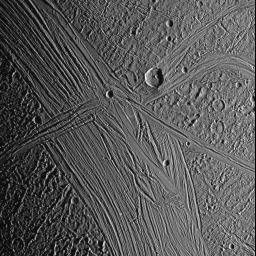
|
Morning in Tiamat Sulcus
- Click the image above for a larger view
- Full-Res JPEG (782 x 784) (205.8 kB)
- Full-Res TIFF (782 x 784) (611.1 kB)
Caption:
View of the Tiamat Sulcus region on Jupiter's moon, Ganymede, imaged just after local sunrise. The illumination from such a low sun angle highlights the grooved topography of Tiamat. Furrows and fractures are apparent in the surrounding dark terrain also. North-south trending Tiamat Sulcus is divided in two by Kishar Sulcus, which trends east-west. The southern portion of Tiamat is wider than its northern portion, indicating that there has been a greater degree of extension south of Kishar Sulcus than north of it. The portion of Kishar Sulcus to the right of Tiamat Sulcus appears to have slid horizontally (with respect to the left portion of Kishar Sulcus) along a northwest-southeast trending strike-slip fault.
North is to the top of the picture and the sun illuminates the surface from the right. The image, centered at 1 degree south latitude and 204 degrees longitude, covers an area approximately 386 by 387 kilometers. The resolution is 494 meters per picture element. The image was taken on May 7, 1997 at 14 hours, 15 minutes, 7 seconds Universal Time at a range of 48,859 kilometers by the Solid State Imaging (SSI) system on NASA's Galileo spacecraft.
Background Info:
The Jet Propulsion Laboratory, Pasadena, CA manages the Galileo mission for NASA's Office of Space Science, Washington, DC.
This image and other images and data received from Galileo are posted on the World Wide Web, on the Galileo mission home page at URL http://solarsystem.nasa.gov/galileo/ . Background information and educational context for the images can be found at http://www.jpl.nasa.gov/galileo/sepo .
Cataloging Keywords:
| Name | Value | Additional Values |
|---|---|---|
| Target | Ganymede | |
| System | Jupiter | |
| Target Type | Satellite | |
| Mission | Galileo | |
| Instrument Host | Galileo Orbiter | |
| Host Type | Orbiter | |
| Instrument | Solid-State Imaging (SSI) | |
| Detector | ||
| Extra Keywords | Grayscale | |
| Acquisition Date | ||
| Release Date | 1998-07-15 | |
| Date in Caption | 1997-05-07 | |
| Image Credit | NASA/JPL/Brown University | |
| Source | photojournal.jpl.nasa.gov/catalog/PIA01619 | |
| Identifier | PIA01619 | |
